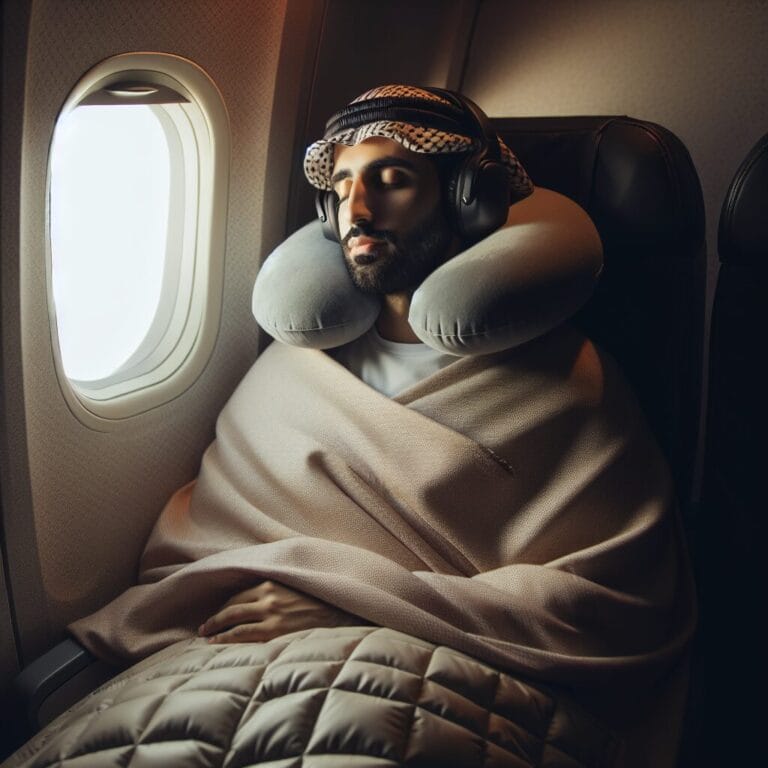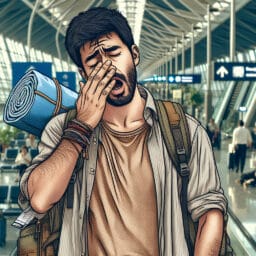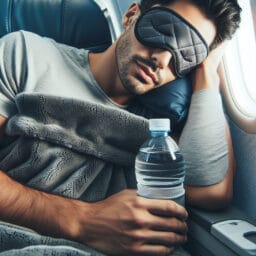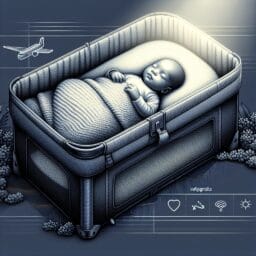
Mastering Sleep on the Go: Top Optimization Tips for Frequent Traveling Adults
Table of Contents
- Introduction
- Understanding Sleep and Travel
- Pre-Travel Preparation
- Sleep Optimization Strategies During Travel
- On-the-Go Sleep Habits
- Technology and Sleep Aids
- Diet and Exercise for Better Sleep
- Addressing Sleep Disorders and Seeking Professional Help
- Conclusion
- Frequently Asked Questions
Introduction
Picture this: You’re buckled in for a long-haul flight, and the cabin lights dim. It’s like your internal clock perks up saying, “Let’s get that shut eye!” But as you try to nod off, there’s noise, light, and oh boy, isn’t it just too cramped? Here’s where some nifty tricks swoop in to help reset your circadian rhythm. First off, snagging that window seat not only gives you control over light exposure but also a wall to lean on—comfy! Now, don’t forget those travel pillows and noise-canceling headphones; they’re like your personal bubble against the hubbub.
A few days leading up to your trip, gradually shift your sleep schedule closer to the local time of your destination—it’ll ease the shock your sleep habits face when hopping between time zones. Sipping water throughout your journey keeps dehydration at bay (and trust me, travel fatigue hates hydration). Some travelers swear by weighted blankets too—they add gentle pressure to help you stay asleep. And here’s a hot tip: if falling asleep is tough cookies for you, consider natural sleep aids or even adjusting behavior like cutting out screen time before beddy-byes.
Ultimately, these tweaks aren’t just about catching Zs—they’re about improving sleep quality so you wake up feeling more superhero than snooze-button champion. Happy travels!

Understanding Sleep and Travel
Did you know that your circadian rhythm, sort of like an internal master clock, can take up to a day to shift just one time zone? That’s quite the hiccup for those crossing multiple zones! When we hop across the globe, our circadian clocks can lag behind or jump ahead of local time, leading to the dreaded jet lag. But fear not! Your travel toolkit can include more than just sleep aids and comfy travel pillows.
Let’s zoom in on some science magic: melatonin is your new best friend. This hormone helps regulate your sleep schedule and tells your body when it’s time to hit the hay. It gets confused when you’re flashing between time zones faster than lightning. A little help from melatonin supplements can give it that much-needed nudge. Remember though, timing is everything – taking them too early or late could mean lullabies at lunchtime!
Another heavyweight champ in your corner against travel fatigue and sleep problems is food. Yep, munching meals at times aligning with your destination’s clock before you travel can pre-set your internal timer for success. And once there, soaking up sunshine will whisper sweet nothings to your circadian clock about the local time.
Now get this: outfits matter more than you think! Rock loose clothing on flights so nothing digs into you while trying for a good night’s sleep — because fashion should never fence in your shut-eye dreams.
Travelers must also tackle what happens when lids snap shut; that’s where quality rest kicks in. Create a sleep sanctuary even when away from home—blackout curtains, staying hydrated (no coffee or booze close to bedtime), and ensuring the room temperature is just right are puzzle pieces to peace.
So whether curled up in a window seat as skies blush pink or snug under weighted blankets after a long-haul flight adventure, these tips are all about helping reset your system faster than ever.stantiateViewController
Pre-Travel Preparation
When embarking on a globe-trotting adventure, your sleep quality should take center stage. Imagine stepping off the plane not just ready to explore but also bursting with energy—dreamy, right? One way to ensure this is by syncing your slumber with your destination’s clock well before your departure. Days leading up to your travels, gradually adjust bedtime and wake-up calls to mirror the local time of where you’re headed. Think of it as giving your internal clock a gentle nudge rather than an alarming shock when you land.
Comfort is key for a good night’s sleep, whether perched in economy or lounging in first class—yes, that means splurging on those plush travel pillows that cradle your neck like a cloud and maybe even snuggling into a compact weighted blanket that wraps around you with just enough pressure to lull you into dreamland. These are not mere accessories; they’re essentials for keeping travel fatigue at bay and allowing you to stay asleep amidst the hubbub.
Now let’s talk tactics: beyond leaning on sleep aids, strategic snoozing during flights helps reset your rhythm. If it’s nighttime at your destination, try catching some shut-eye mid-air; if it’s daylight when you arrive, resist the urge to hit the sack immediately. Instead, soak in some natural light exposure—it’s like sending a direct message to your circadian clock that it’s go-time (or glow-time?).
And hey, don’t overlook what you pack! Those comfy outfits aren’t just fashion statements—they’re part of the grand plan to improve sleep quality while soaring across time zones. Loose-fitting clothes are more than trendy airport attire; they’re peacekeepers between restfulness and restlessness.
Wielding these strategies correctly can turn potential nightmares about long-haul flights into dreams of worldwide wonders waiting for you—without losing precious shut eye!
Sleep Optimization Strategies During Travel
Did you ever consider that the place you choose to stay while traveling could be a secret weapon against groggy, sleep-deprived days? The truth is, where you lay your head at night can make or break your quest for quality rest. Picture this: You find a cozy inn that sports mattresses like fluffy clouds and pillows that seem to whisper sweet dreams into your ear – it’s not too good to be true! When booking accommodations, peek at reviews focused on sleep comfort; trust me, fellow travelers love to spill the beans on beds that are snooze-worthy.
Once you’ve claimed your slice of sleep heaven away from home, transform it into a sanctuary of slumber. Let’s say the curtains are thinner than your patience after a day zipping through time zones – no sweat! Pack an eye mask that’ll plunge you into darkness or better yet, request room darkening shades as part of your stay. And if eerie silences or unfamiliar bumps in the night have you wide-eyed, those noise-canceling headphones double as a personal white-noise machine.
Speaking of jet lag—ugh, right? It’s like your internal clock throws a tantrum every time zones come into play. But here’s an ace up the sleeve: exposure to natural light during peak daytime hours helps reset that stubborn circadian clock faster than you can say “lights out!” So take a brisk walk in the sunshine after landing (bonus points for exercise), and resist napping until it’s local bedtime. Sure, coffee might beckon like a siren call when energy dips hit but dodge its lure close to bedtime; caffeine is basically jet lag’s accomplice in crime.
Now let’s not forget about hydration – keeping well-watered isn’t just good for flowers; it helps combat travel fatigue so you feel less like a wilted daisy and more like a perky sunflower ready to seize the day—or night! And remember those nifty travel pillows and weighted blankets? They’re not only for flights; they bring familiar comfort anywhere you go, signaling your body that it’s snooze season even when miles away from home.
So gear up for globetrotting without compromising on those precious Zs. With each transition across long-haul flights and new locales, having these strategies in play means diving into adventures with energy reserves full and sleep problems waved goodbye from yesterday’s horizon.
On-the-Go Sleep Habits
Did you know that napping isn’t just for toddlers and grumpy grandpas? That’s right, even on-the-go grownups can harness the power of a quick snooze to recharge batteries mid-travel. However, the secret sauce is timing your naps like a pro—too long or too late in the day, and you risk turning night into a wide-awake nightmare. Aim for a 20-minute power nap to zap travel fatigue without throwing off your sleep schedule. This little pause can be a game-changer, giving your brain a mini vacation so you’re sharp for adventures ahead.
Now, let’s chat about what you sip and nibble on those trains, planes, and automobiles. Water should become your trusty travel sidekick—sip it often to stay hydrated because hydration is like an internal spa keeping everything running smoothly. On the flipside, watch out for caffeine and alcohol; they’re sneaky villains when it comes to stealing quality rest at night. Tip: opt for herbal tea or water over coffee or cocktails close to bedtime. These simple swaps can help ward off restless nights and ensure you fall asleep with ease when it’s finally time to hit the hay.
Before we wrap this up, let’s dive into tranquility tricks that could make monks jealous! Ever heard of mindfulness practices? Think gentle breathing exercises or visualizing peaceful scenes—the beach at sunset, perhaps? These relaxation techniques are not just fluffy feel-good stuff; they prime your mind for sublime shut eye by calming those pre-sleep jitters. Whether it’s yoga stretches before takeoff or whispering sweet nothings of gratitude as stars twinkle outside your window seat—cultivating calmness is key to conquering sleep problems during travel.
So there you have it: master the artful nap, keep tabs on drinks that mess with sleep habits, and invite inner peace as if it’s an old friend coming along for the journey. Embrace these insights with open arms (and eyes ready to close), paving the way toward dreamland even when hopping through time zones.

Technology and Sleep Aids
Ever imagined a high-tech sleep guardian angel? Well, welcome to the future where sleep tracking and analysis apps work like magic in your pocket! These nifty little helpers go beyond counting sheep; they dive deep into understanding your snooze patterns. By tracking when you drift off and how long you bask in REM cycles, these apps can offer personalized tips to help fine-tune your slumber routine. And for those of us zigzagging across time zones, some apps even provide jet lag management plans – it’s like having a sleep coach that fits right inside your carry-on!
Now let’s talk about creating a bubble of silence with noise-canceling headphones or earplugs. They aren’t just gadgets; they’re your defense against the symphony of snoring passengers or that hotel by the train tracks. Pop them on and you’ll be whisked away from chaos to calmness, transforming any bustling space into an oasis of peace perfect for catching some shut-eye.
But wait—there’s more! Portable sleep devices are stepping up their game too. Can’t imagine sleeping without your special pillow? What if there was a travel-sized version that could inflate to mimic its comforting support? Or perhaps wearables are more your style – wristbands that gently vibrate when it’s prime time to snooze or glasses emitting light therapy to keep your internal clock ticking on point.
These innovations aim at one thing: making sure travel doesn’t spell trouble for restful nights. So whether you’re nestled in a window seat under starry skies or tucked away in a quiet hotel room, embrace these tech wizards as part of your journey towards improving sleep quality while embracing the adventures of travel!
| Type | Description | Benefits |
|---|---|---|
| Sleep Tracking and Analysis Apps | Apps that monitor sleep patterns and provide personalized tips. | Improves sleep routine, offers jet lag management. |
| Noise-Canceling Headphones/Earplugs | Devices designed to block out external noise. | Creates a quiet environment for better sleep. |
| Portable Sleep Devices | Travel-friendly gadgets including inflatable pillows and light therapy glasses. | Provides comfort and helps maintain internal clock while traveling. |
| Wearable Sleep Aids | Wristbands and other wearables that promote optimal sleep times. | Gently encourages sleep at the best times for the user. |
Diet and Exercise for Better Sleep
Imagine this: You’ve just landed in a new time zone, and your body is screaming for sleep. But wait, did you know that certain foods can be like lullabies to your tummy, whispering sweet dreams to your circadian rhythm? Yes! Chowing down on goodies rich in melatonin such as cherries or bananas could help coax those eyelids into submission before bedtime. Equally magical are snacks packed with tryptophan—an amino acid found in turkey and milk that acts like a natural sedative. So, next time you’re jet-setting, pack these sleep-friendly treats for an edible ticket to dreamland.
But here’s the rub: indulging in heavy meals or caffeine-loaded drinks close to snooze o’clock might turn your night into a spinning merry-go-round of restlessness. Heavy meals take a lot of work for your body to digest—think of it as putting your insides through night shifts—and stimulants like caffeine are notorious for throwing punches at sleep quality. By choosing lighter fare and sipping on calming herbal teas instead, you’ll arm yourself against the dreaded insomnia beast that often lurks around hotel rooms.
And don’t forget about striking the perfect balance with exercise while on the move. Taking long walks or doing some gentle yoga stretches can be like hitting the reset button on travel fatigue. Exercise not only tires you out in the good kind of way but also gets your blood flowing, which helps recalibrate your internal clock faster than you can say “jet lag.” The trick is timing; get moving during daylight hours to soak up that sunshine, nudging your circadian clock towards alignment with local time.
In essence, shaping what goes on (and in) your plate and weaving in some physical activity is a two-pronged strategy that doesn’t just fend off travel weariness—it invites serenity into every fiber of your being, setting you up for nights full of quality rest no matter where in the world you find yourself tucked in!
Addressing Sleep Disorders and Seeking Professional Help
Getting a good night’s sleep can sometimes feel like hunting for treasure, and this quest doesn’t get any easier when you’re navigating the choppy waters of travel. While we’ve uncovered ways to set our internal clocks to the rhythm of new time zones, there’s an anchor that could be weighing down your shut-eye: undiagnosed sleep disorders. The rocking of planes or trains might not just disrupt circadian rhythms; it could also highlight underlying issues such as sleep apnea or insomnia, which are pesky bedfellows making it hard to fall asleep even in the comfort of one’s bed, let alone on a long-haul flight.
Suppose you find yourself staring at the cabin’s ceiling more often than catching Zs, despite following all the best advice for travel fatigue. In that case, it might be time to chat with a sleep specialist. Seeking medical advice before embarking on your next journey ensures you’re equipped with strategies or treatments tailored to your needs—be it a CPAP machine for quiet respiration amongst the clouds or cognitive-behavioral therapy (CBT) sessions to smooth out anxiety-induced insomnia before takeoff.
For travelers seeking solace from restless nights but wary of starting long-term treatment, temporary solutions abound. Short-term use of prescription medications under professional guidance can provide relief without committing to a steady regimen. Moreover, emerging portable therapies make managing sleep disorders more convenient for globe-trotters. Light therapy devices can help reset circadian clocks disrupted by jet lag, whereas mindfulness apps may guide those wound up from adjusting behavior in unfamiliar beds towards well-deserved rest.
No matter where your travels take you—a window seat above the clouds or a hammock swaying under foreign stars—knowing and addressing potential sleep problems ensures that every adventure is energized by quality rest. So pack your bags and your travel pillows but leave no stone unturned when it comes to securing tranquil shut-eye amidst your escapades.
Conclusion
Setting off on your travel adventures can be thrilling, but don’t let the excitement overshadow the superhero ingredient to any trip—quality rest! To keep the pep in your step across time zones, consider this: light exposure isn’t just for plants; it’s crucial for travelers too. Syncing with local time becomes less of a puzzle when you bask in the morning’s golden rays or dim the lights as dusk falls, nudging that internal clock in the right direction.
If there’s one thing to pack alongside those travel pillows and noise-canceling headphones, let it be a schedule—a sleep schedule. Chart out times for slumber based on your destination even before you launch into the skies. This pre-planning is not about being rigid; it’s about giving yourself a blueprint to battle jet lag and maintain that circadian rhythm harmony.
Now, ever thought of hydration as your personal health concierge? Staying hydrated doesn’t just quench thirst; it ensures every cell in your body functions like a well-oiled machine ready to conquer long-haul flights and new explorations with vigor. And here’s a slick trick: resist those inflight coffees and nightcaps—they’re sneaky disruptors to catching those much-needed Zs.
When you finally recline in that window seat or tuck under hotel sheets, let these tailored tips be your passport to dreamland. By adjusting behaviors beforehand, embracing sleep aids wisely, and tuning into local cues like light exposure, you’ll be fast asleep while others are counting sheep. Say goodbye to travel fatigue with open-eyed enthusiasm for each day’s journey because good nights lead to great days—jet lag has left the building!



